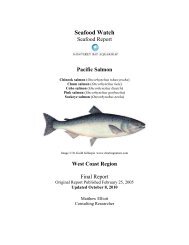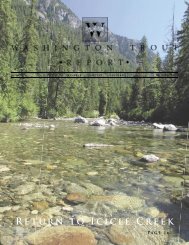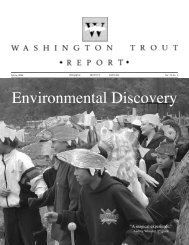Whidbey Island Near Shore Research Project
Washington Trout Report - Wild Fish Conservancy
Washington Trout Report - Wild Fish Conservancy
- No tags were found...
You also want an ePaper? Increase the reach of your titles
YUMPU automatically turns print PDFs into web optimized ePapers that Google loves.
Ducks, Dikes, and My Dosewallips<br />
The Many Benefits of Ecological Restoration<br />
by Doug Rose<br />
Photo: Kurt Beardslee<br />
Doug Rose is a former member of the Washington Trout Board of Directors, an avid conservation advocate, a broadly<br />
experienced, reflective, and responsible outdoorsman, and an exceptionally talented writer. His most recently published book<br />
is “The Color of Winter; Steelhead Fly Fishing On The Olympic Peninsula,” available from Frank Amato Publications.<br />
Doug is a long time resident of the Olympic Peninsula, and happens now to live within a stone’s throw of our Dosewallips<br />
Estuary Restoration <strong>Project</strong>, in the Hood Canal community of Brinnon, Washington. We are proud to offer our members and<br />
supporters the opportunity to explore Doug’s thought-provoking perspective on the varied benefits of the project. – Ed.<br />
The removal of the dikes at the Dosewallips River<br />
estuary did more than just improve salmon habitat: It also<br />
made life easier for the waterfowl that winter along Hood<br />
Canal near the estuary. A few dozen mallards and greenwinged<br />
teal nest in this area, but most of the wintering<br />
ducks are migratory birds. Many spend a few days or<br />
weeks, then continue south to the Columbia estuary,<br />
Willamette Valley or California. But several thousand<br />
remain.<br />
Mallards, widgeon, pintails, green-winged teal,<br />
bufflehead, hooded mergansers and Canada geese are the<br />
most common species. They feed in the salt marsh, tide<br />
flats and sloughs in the Dosewallips estuary and the salt<br />
ponds and tidal guts at Wolcott Slough, the U. S. Fish and<br />
Wildlife Service property near the Brinnon motel. Black<br />
brant also pluck eelgrass and peck gravel on low tides,<br />
and scaup and goldeneye seek refuge in nearshore waters<br />
during storms.<br />
I live less than a half mile north of the river, at the<br />
edge of the salt marsh and between two major sloughs.<br />
I am a duck hunter. My yellow Labrador, Lily, and I<br />
spend time nearly every day between mid-October and<br />
late January in blinds along the canal and near the upper<br />
edge of the marsh. In the past, ducks routinely flew near<br />
us as they traded between the Dosewallips delta and<br />
Wolcott Slough. They flew north around Sylopash Point<br />
when a stiff southern wind and incoming tide made them<br />
uncomfortable at the Dosey, exposed to 30 miles of<br />
20






